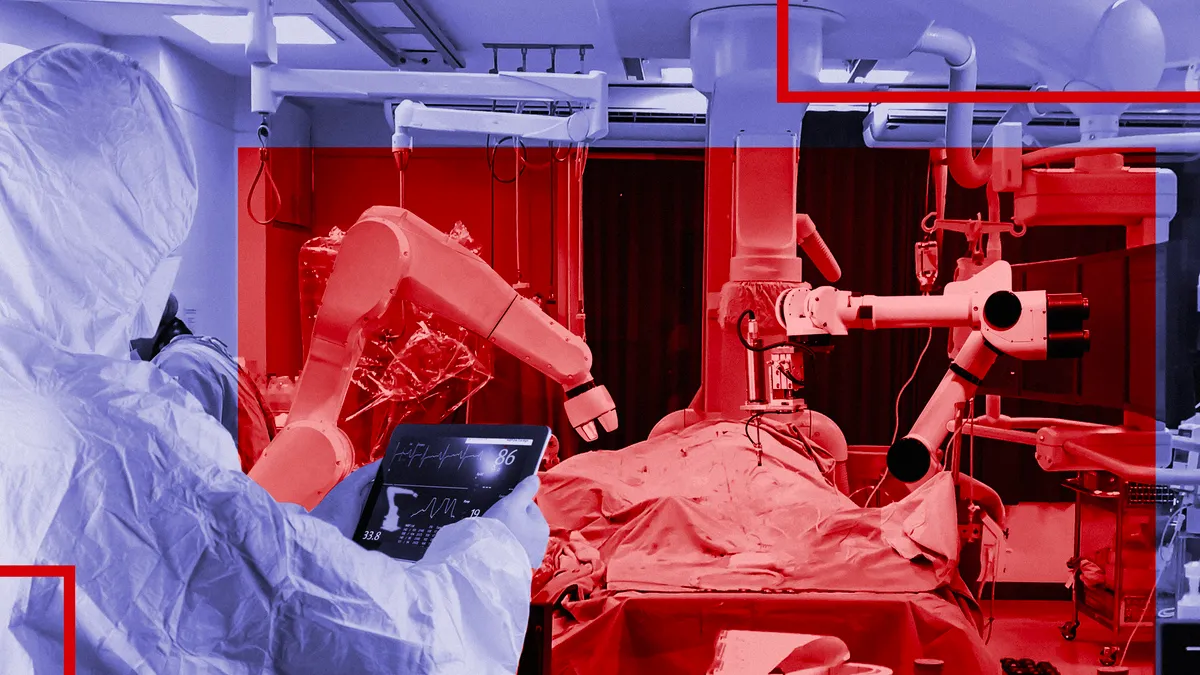This story is part of a MedTech Dive series examining the impact of the COVID-19 pandemic on the medtech industry, published one year after the start of the crisis. You can find the other stories here.
By the end of 2019, Intuitive Surgical's dominance over soft-tissue surgical robotics looked threatened as giants like Johnson & Johnson and Medtronic set their sites on the space. Amid big acquisitions and anticipated new robotics systems, questions arose if the longtime leader would be able to fend off competition.
At the same time, Zimmer Biomet and Stryker were launching robotic systems for orthopaedics procedures like knee and hip replacements, trumpeting the potential of the emerging tech.
Then the coronavirus pandemic hit the world in 2020, dramatically altering the healthcare landscape.
Elective procedures fell significantly in March, April and May and briefly rebounded before another drop in November and December, taking down business segments for companies across the medical device industry. But despite this hit to surgeries, most robotics companies came out of 2020 with demand for their systems surviving.
"Although there was a disruption of elective procedures around the world, the interest in robotics has not changed," said Robert Cohen, president of digital, robotics and enabling technologies for Stryker. "The excitement about robotics that existed before the pandemic … continued through the pandemic."
Now, roughly one year after the pandemic took hold, companies are seeking to maintain that momentum in system demand and meet the high expectations for the market as procedures return.
Ortho competition heating up
The orthopaedic space was one of the hardest-hit procedure segments last year. J&J, Stryker and Zimmer all reported declines for their hip and knee businesses in 2020, with some segments declining by double digits compared to 2019.
However, despite the financial pressures on hospitals due to losing elective procedures, a lucrative business line for the industry, robotic placements in orthopaedics remained strong coming out of last year.
Stryker and Zimmer both placed over 100 systems for their Mako and Rosa systems in the fourth quarter, respectively.
SVB Leerink analyst Richard Newitter explained that placements are not always direct sales. Placements can be outright sales, sales leased by a third, independent party, or a system can be placed in exchange for a procedure volume commitment and longer-term payment plans.
Still, Evercore ISI analyst Vijay Kumar said that placements are the leading indicator of future revenue growth as a company's robotics system are used exclusively for that company's joint implants.
Even though placements for Zimmer and Stryker were up last year, any meaningful acceleration for robotics hinges on the return of procedures. And questions still remain regarding exactly how and when procedures will come back.
Zimmer CEO Bryan Hanson warned of a challenging first quarter in 2021, but industry and analysts both project a second-half recovery as vaccine rollouts continue and the pressure on hospitals from COVID-19 surges eases, which could fuel the ongoing competition in the orthopaedic market.
Kumar contends there's room to grow for robotics in orthopaedics as the market is 10-12% penetrated; he also estimates the U.S. knee market alone could become a $5 billion market in the next 10 years.
Stryker is seen as the leader of orthopaedic robotics, offering total and partial knee applications and a total hip application through Mako, but Zimmer is gaining ground. The company exceeded its goal of placing 200-300 Rosa systems in 2020, and while Rosa only offers total knee procedures, launches for a partial knee and total hip application are planned for later this year.
Competition in orthopaedics will also build as J&J steps in with a robot system through DePuy Synthes, a company under the healthcare giant's medical device business.
DePuy Synthes, which specializes in orthopaedics, received 510(k) clearance from the FDA for its Velys robot-assisted system in January. The system, cleared to work with the company's Attune total knee offering, is available now and will be rolled out through 2021.
Aldo Denti, the company group chairman for DePuy Synthes, said there is still room for another system due to a low penetration by robotics into the orthopaedic space. The company is targeting both inpatient hospitals and outpatient settings like ambulatory surgical centers, where procedures like hips and knees have been migrating over the last several years, especially during the pandemic.
Denti expects Velys installations to "outpace what competitors have done in the past."
Once normal hospital operations return, an important question remains for robotics: How much volume can the systems take over from traditional surgeries?
Stryker's Mako accounted for about 44% of total knee procedures in the U.S. in the fourth quarter. Cohen said that over 90% of Stryker's partial knee replacements globally are being done with the robot and, in the next several years, the majority of global total knee procedures for the company will be performed with Mako.
Meanwhile, a single-digit percentage of total knee procedures for Zimmer is done with Rosa, according to the company.
By 2030, about 30% of all total knee procedures are projected to be done via robotic systems, according to Sharrolyn Josse, DePuy Synthes' worldwide president of the Velys Digital Surgery division.
J&J has been a latecomer to the orthopaedic robotics space; however, the company expects to compete at the top of the market with Zimmer and Stryker. And while DePuy Synthes would not project any specific numbers for target procedure percentages for total knee surgeries, Josse said that the company plans "to be very aggressive and be a significant leader in that market."
Slower momentum for hips
After total and partial knee replacements fueled robotics adoption, companies are now more closely focusing on total hip replacements.
Stryker's Cohen said that the percentage of robotic total hip replacements versus traditional procedures is lower than in total knees but there has been recent acceleration. The company used knee procedures to drive Mako placements and can now focus on hip procedure adoption because surgeons have become more comfortable with the robot.
Zimmer is entering the robotics hip market for the first time this year, with plans to launch their total hip application for Rosa in the second half of 2021. And after Zimmer spins off its spine and dental segments, the company will have more resources to aim at the hip and knee markets.
Despite a growing focus on hips for robotics, the market may still trail behind knees for the foreseeable future, according to Kumar.
Benjamin Domb, founder and medical director of the American Hip Institute, a clinic specializing in hip treatments and surgeries, said that adoption will be a bit slower for hips and an environment where the majority of surgeries being conducted with a robot is a long way off. He explained that some surgeons will conduct close to 100% of surgeries with a robot, while others will not use a robot at all.
Adoption hurdles include a steep learning curve, which slows procedures down, according to Domb, who has been working with robotics since 2011 and was part of the development team for the Mako hip platform. Other barriers to entry exist, such as hospitals not being able to afford or not willing to spend the capital on costly robotics systems.
As for the entrance of Zimmer's Rosa into the hip space, Domb said that there will likely be brand loyalty among surgeons once they establish comfortability with a system.
Intuitive's 2020 slowdown
While orthopaedic systems gained momentum last year, placements of Intuitive Surgical's soft-tissue system, called da Vinci, slowed down. The company placed a total of 936 da Vinci systems in 2020, compared to 1,119 the prior year.
Brian Miller, the chief digital officer for Intuitive, said that the pandemic created uncertainty throughout last year for procedures as well.
"When we went throughout [2020], it was hard to forecast what the next quarter was going to look like as the pandemic unfolded," Miller said. "When we got to the end of the year ... one thing we saw was when people decided to do procedures, they still used our platforms and our technology."
In 2020, procedures grew 1% to 1.25 million, according to Intuitive's most recent earnings call. By contrast, procedures grew by about 18% in 2019 and 2018.
Miller said that the company still has a target of about 6 million procedures annually. However, the pandemic has slowed the timeline for hitting this mark, and Miller would not provide details on when that target can be met.
Baird Equity Research analyst Mike Polark said Intuitive's number of placements and procedures was still impressive despite the decline and slowdown. The procedure comeback that did happen last year and the capital spending among hospitals were both above expectations after the first months of the pandemic when electives were largely shut down across the U.S. and hospitals' finances were in jeopardy.
But there is no refuting that after spending years as the clear market leader in robotics, Intuitive faces looming competition.
Medtronic plans to submit for a CE mark and an investigational device exemption with the FDA this month for its Hugo soft-tissue system, and Evercore's Kumar said the system is likely to hit the market in the fourth quarter of this year.
J&J also plans to enter the soft tissue space with its Ottava system. However, with first-in-human trials set to begin in the second half of 2022 and the company not committing to a timeline during a recent investor event, it could be several years before the system is available.
While some loss in the market for Intuitive is expected, both analysts Kumar and Polark predict they will remain the leader and pointed to further penetration in markets like China and Japan as growth drivers, as the U.S. market becomes further developed.
Competitors could ultimately get about 20-40% of the soft tissue market, but that range is still at least five years off, Kumar said.




















